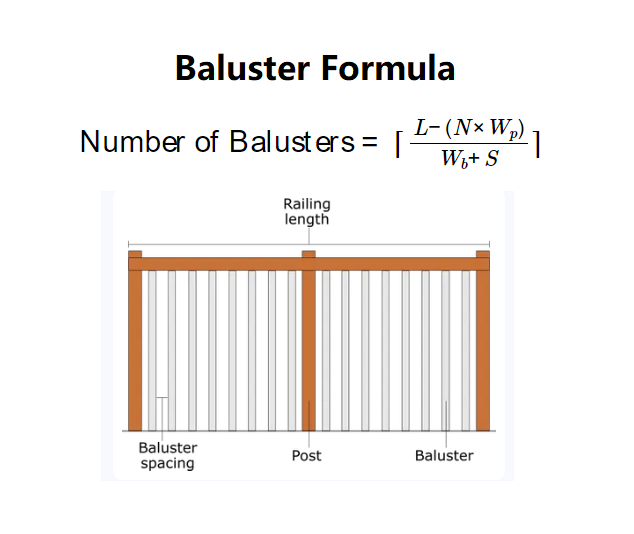1. What is Baluster Calculator?
Definition: This calculator determines the number of balusters needed for a railing based on the railing length, number of posts, width of each post, baluster width, and spacing between balusters.
Purpose: It is used in construction and carpentry to plan railings for staircases, decks, or balconies, ensuring compliance with safety codes (e.g., maximum spacing) and aesthetic requirements.
2. How Does the Calculator Work?
The calculator uses the following formula:
- \( \text{Number of Balusters} = \lceil \frac{L - (N \times W_p)}{W_b + S} \rceil \)
Where:
- \( L \): Railing length (in, converted from selected unit);
- \( N \): Number of posts;
- \( W_p \): Width of a single post (in, converted from selected unit);
- \( W_b \): Width of a single baluster (in, converted from selected unit);
- \( S \): Spacing between balusters (in, converted from selected unit).
Steps:
- Enter the railing length (\( L \)) with its unit.
- Enter the number of posts (\( N \)).
- Enter the width of a single post (\( W_p \)) with its unit.
- Enter the width of a single baluster (\( W_b \)) with its unit.
- Enter the spacing between balusters (\( S \)) with its unit.
- Convert \( L \), \( W_p \), \( W_b \), and \( S \) to inches (common unit for calculation).
- Calculate the effective length: \( L - (N \times W_p) \).
- Calculate the baluster unit: \( W_b + S \).
- Calculate the number of balusters: \( \lceil \frac{L - (N \times W_p)}{W_b + S} \rceil \).
- Display the result as a whole number.
3. Importance of Baluster Calculation
Calculating the number of balusters is crucial for:
- Safety Compliance: Ensuring the spacing between balusters meets building codes (e.g., no more than 4 inches in many regions to prevent children from slipping through).
- Material Estimation: Determining the exact number of balusters needed to avoid over- or under-purchasing materials.
- Aesthetic Design: Achieving a balanced and visually appealing railing by evenly distributing balusters.
4. Using the Calculator
Example 1 (Same Units): Calculate the number of balusters for a railing:
- Railing Length: \( L = 20 \, \text{ft} \);
- Convert \( L \): \( L = 20 \times 12 = 240 \, \text{in} \);
- Number of Posts: \( N = 5 \);
- Post Width: \( W_p = 2 \, \text{in} \);
- Baluster Width: \( W_b = 2 \, \text{in} \);
- Baluster Spacing: \( S = 3 \, \text{in} \);
- Effective Length: \( L - (N \times W_p) = 240 - (5 \times 2) = 230 \, \text{in} \);
- Baluster Unit: \( W_b + S = 2 + 3 = 5 \, \text{in} \);
- Number of Balusters: \( \lceil \frac{230}{5} \rceil = \lceil 46 \rceil = 46 \);
- Result: \( 46 \, \text{balusters} \).
Example 2 (Mixed Units): Calculate the number of balusters for a railing:
- Railing Length: \( L = 3 \, \text{m} \);
- Convert \( L \): \( L = 3 \times 39.3701 = 118.1103 \, \text{in} \);
- Number of Posts: \( N = 4 \);
- Post Width: \( W_p = 5 \, \text{cm} \);
- Convert \( W_p \): \( W_p = 5 \times 0.393701 = 1.9685 \, \text{in} \);
- Baluster Width: \( W_b = 2.5 \, \text{cm} \);
- Convert \( W_b \): \( W_b = 2.5 \times 0.393701 = 0.98425 \, \text{in} \);
- Baluster Spacing: \( S = 10 \, \text{cm} \);
- Convert \( S \): \( S = 10 \times 0.393701 = 3.93701 \, \text{in} \);
- Total Post Width: \( N \times W_p = 4 \times 1.9685 = 7.874 \, \text{in} \);
- Effective Length: \( L - (N \times W_p) = 118.1103 - 7.874 = 110.2363 \, \text{in} \);
- Baluster Unit: \( W_b + S = 0.98425 + 3.93701 = 4.92126 \, \text{in} \);
- Number of Balusters: \( \lceil \frac{110.2363}{4.92126} \rceil = \lceil 22.4 \rceil = 23 \);
- Result: \( 23 \, \text{balusters} \).
5. Frequently Asked Questions (FAQ)
Q: Why do we round up the number of balusters?
A: Rounding up ensures that the entire railing length is covered with balusters, even if the last space is slightly smaller than the standard spacing, maintaining safety and aesthetics.
Q: What is the typical spacing for balusters?
A: Building codes often require baluster spacing to be no more than 4 inches (approximately 10 cm) to prevent small children from slipping through. Always check local regulations.
Q: Can this calculator be used for curved railings?
A: This calculator assumes a straight railing. For curved railings, you may need to measure the arc length and adjust the calculations accordingly, or consult a specialized tool.
 Home
Home
 Back
Back
